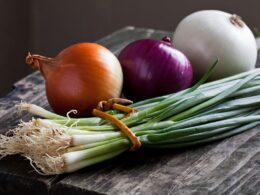Learn about the different types of plums and their health advantages. There are many different kinds; continue reading to learn more about them.
A plum is a smaller, sweeter fruit that can be eaten raw or cooked in desserts.
It is juicy and soft. The Latin word “Malum punicum,” which translates to “the fruit of a kind of ancient Mediterranean plum,” is where the word “plum” originates.
Originally from Iran, plums are now grown worldwide. There are numerous plums, including European and Japanese (black, red, and yellow) (Moyer, greengage, Mirabelle, and pluots).
Furthermore, numerous varieties of plums are grown close to populated areas rather than in the wild. Because of this, some types may be well-known to others.
Plums can have sweet and juicy flesh and skin with a tart flavor. Most plums can be consumed raw and fresh, but some are best dried and made into prunes.
In reality, plum juice is used to ferment some wines. Plum jerked, a product made from plums, can be produced in central England. Also, it is comparable to alcoholic cider.
Contrarily, the flavor of dried plums or prunes is generally sweet and reminiscent of grapes or raisins. Unripe plums have a sour flavor similar to citrus fruits.
Different Types of Plums
Without much ado, these are the different types of plums;
1. Japanese Black Plum
Black plums typically have a mild to sweet flavor and range in color from bright red to deep purple.
They are usually used in foods like plum tarts because they don’t crumble when baked or cooked.
This contributes to the dish’s appearance and texture looking more finished.
Even more impressive is that using black plums in your recipes causes the dish’s dark skin to diffuse a lovely purple hue.
2. Japanese Black Ruby
Black Ruby is a round, reddish-brown plum with flesh that is yellowish-orange.
Black ruby has a freestone center, which means that the stone can easily be separated from the flesh, unlike the centers of other varieties of plums.
Other varieties of Japanese plums, however, are “clingstone” varieties, in which the flesh is tightly bound to the pit.
Black Ruby trees are grown in the humid regions of the southern and Mediterranean areas because they can easily withstand the humid climate, according to the Clemson University Horticulture website.
3. Friar
Friar is a different variety of Japanese black plum with lighter-toned amber flesh. Friars have a rounded shape and range in color from deep violet to bright black.
This sweet, juicy, and late-season plum has a tiny pit. Since Friar plums typically reach maturity three weeks after Black Ruby, they take longer to ripen. This is one of the different types of plums.
4. Black Beauty
Black Beauty is a deep purple color between medium and full size.
When this stone fruit is firm and soft, it is incredibly juicy. Avoid hard, small plums and unusual spots on them.
Furthermore, one quick and easy way to ripen Black Beauty is to leave it in a paper bag at room temperature.
Midseason is the best time to purchase Black Beauty at grocery stores (spring and fall).
5. Black Splendor
This plum, which is still relatively new, has a bluish-black color and tastes delicious.
These fruits come in medium to large sizes and have moist and reddish flesh.
Also, Black Splendor, in contrast to Black Beauty and Friar, is a plum that can be harvested from June 5 to June 20. This is one of the different types of plums.
6. Mirabelle Plum
The mirabelle plums, also known as a cherry plume or mirabelle prune, were derived from a wild fruit from the European plum family cultivated and grown in Anatolia.
However, due to some import laws in Lorraine, France, where it is grown, this particular variety of plum fruit is prohibited in the United States.
Furthermore, the mirabelle plums have a sweet, enticing, and mellow flavor.
Mirabelle fruit is used in fruit preserves and sweets like pies made with plum trees in the area.
In contrast, the juice can be distilled into plum brandy or fermented into wine. The best way to eat this plum is fresh and raw.
7. Elephant Heart Plum
The fruit of the elephant heart plum is heart-shaped and has seed stones where the flesh doesn’t adhere, living up to its name.
Opening the plum fruit reveals its deep red flesh, which is also juicy.
The harvest will be at its best if elephant heart plums are cross-pollinated with other varieties like Santa Rosa or Beauty.
Furthermore, this variety yields plum fruits with a tart, sweet, and floral flavor.
Also, it can be consumed raw or added to some desserts, such as plum cornmeal cake. This is one of the different types of plums.
8. Greengage Plum
The typical European plum family includes greengage plums. The green fruited plum trees produce greengage plums, also known as greengages.
They do well in regions with moderate temperatures. Greengage plums have fruits with a sweet, rich flavor.
Furthermore, different desserts are well known for using this kind of plum.
Greengage plums have a high pectin content, making them excellent for preservation.
Greengage plums can be used in various recipes, such as sashimi or soused fish, jams, and other confections.
9. Cherry Plum
The scientific name for the cherry plum is Prunus cerasifera. They are known as myrobalan plums and are indigenous to Southeast Europe and Western Asia.
Both the British Isles and some regions of North America have been established.
Furthermore, the flesh of cherry plums is soft and juicy. They are renowned for having bold, vibrant tastes.
The tart flavor of the cherry plums counteracts the acidic sweetness it creates.
Also, cherry plums contain nutrients that are good for the nervous system and metabolism of the body.
10. Red Plum
Red plums have a sweet-tart flavor, are a delicious source of excellent antioxidants, and can help you consume more minerals and vitamins.
Moreover, red plums are an intelligent choice for people trying to lose weight.
According to estimates, each plum has just 30 calories, a gram of fiber, a half-gram of protein, 6.5 grams of sugar, and no fat or cholesterol.
Red plums are not only a fantastic aid to weight loss but also to heart health.
They are made up of phenolic substances that stop LDL cholesterol from accumulating in your bloodstream, reducing your risk of heart attack or stroke.
In addition, Red plums have skin that ranges in hue from light red to dark purple. The flesh also varies, some red and others lighter shades of yellow, much like the skin.
According to a 2004 study in the Journal of HortScience, red plums with yellow flesh are less nutrient-rich than those with red flesh.
11. Yellow Plum
Yellow plums, also called lemon plums, are a smaller, rounder variety of plums with yellow flesh and skin.
These juicy fruits offer the consumer the highest quality of plumpness thanks to their crisp and firm texture.
The best time to pick these delectable fruits is from late summer to early fall.
Furthermore, Yellow plums are typically used to make plum brandy, jams, fruit preserves, dessert pies, and juices.
According to research, most yellow plums grown for commercial purposes are turned into jams or fruit brandies.
Yellow plums taste best when they are just picked. If not, the fruit might lose its natural flavor and not taste as vivaciously as it should. This is one of the different types of plums.
12. Moyer Plum
Moyer plums, distinguished from other varieties of plums by their longer shape and less rounded appearance, are considered the best in Europe.
They typically have a sweet flavor and are sold fresh and plump.
You can deliciously add these delectable fruits to various dry dishes because they maintain their sweet flavor once dried.
Furthermore, Moyer Plums are frequently referred to as “sugar plums” because of their exquisitely sweet flavor.
Plant the Moyer Plums’ crop alongside other European plum varieties, such as Brooks Plum, to ensure healthy growth.
The best feature is that Mayor Plums are immune to pest damage.
They do, however, need to be protected from bacteria, which is something that bacterial cankers can do.
13. Plucots
Although plucots and pluots are frequently referred to as the same kind of plums, they are distinct.
An early plum-apricot hybrid, plucots have more plum characteristics than apricot characteristics.
Typically, plucots have a bright pink to the red interior with a yellowish-green exterior.
They are oval, unlike Japanese plums, and have lemony green-yellow skin with noticeable patches of reddish-blue color.
They are frequently used in making mint salsa because they are firm and crisp. Additionally, plucots can be used in delectable recipes like jam, chutney, plum crumbles, etc.
Furthermore, they are a type of plum that ripens in the latter part of July and early August.
Once fully grown, they exhibit firm, crisp flesh that is easily imported into other countries without damage.
14. Pluots
Pluots are sweet and tasty, a hybrid fruit with smooth reddish skin and yellowish flesh.
You can purchase pluots in various flavors at a market, including Dapple Dandy, Flavor Grenade, Flavorglo, and Dinosaur Egg.
Moreover, you must look for firm, vibrant-appearing pluots that are fresh, fragrant, and fragrant to get the most flavor out of them.
Avoid soggy or soft pluots, as they likely haven’t ripened all the way.
Like any other plum, pluots can be stored on the counter for three days and in the refrigerator for one week. This is one of the different types of plums.
15. El Dorado Plum
The El Dorado varieties, which belong to the family of European plums, have dark skin and amber flesh.
Additionally, the flesh has a firm texture and a sweet flavor. In comparison, the skin might impart a tart flavor.
El Dorado’s firm flesh texture can withstand heat, making it an excellent choice for menu items that require cooking.
Although the flesh of the El Dorado plums may be lovely, you can’t go wrong by eating them fresh and uncooked. This is one of the different types of plums.
16. Damson Plum
One of the varieties of plum species within the European plum family is the fleshy fruit known as damascene, which also has one seed.
The insititia varieties of damsons are also grown in other parts of Europe besides Great Britain.
The damson plum tree yields small fruit with vivid, deep blue skin. The fruits may have substantial, flesh-filled stones inside.
Additionally, because of the tartness of the flesh, it has a solid and sour flavor and is not recommended to be eaten raw.
Any time of the day is an excellent time to eat stewed plum fruits of the Damson varieties.
You can serve it as a dessert by whipping some cream and pouring it over the fruit stew.
Furthermore, stewed plums benefit the digestive system due to their fiber content.
Additionally, it should strengthen your immune system and offer many other significant health advantages, including preventing heart diseases, lowering bad cholesterol, boosting energy, reducing your risk of developing certain types of cancer, and much more.
Due to their fiber content, stewed plums are beneficial for the digestive system.
Additionally, it should strengthen your immune system and offer many other significant health advantages, including preventing heart diseases, lowering bad cholesterol, boosting energy, reducing your risk of developing certain types of cancer, and much more.
17. Lemon Plum
One specific variety of plums indigenous to Chile gave rise to lemon plums. A lemon plum’s exterior resembles a lemon, as implied by its name.
The flesh, which tastes like a sweet, tart plum with a hint of lemon flavor, is what sets it apart. As the fruit ripens, the texture of the firm, crisp flesh softens.
Slice some thinly and add a little salt to the lemon plums to enjoy them fresh and raw.
You can add it to salads or cook it with sugar to make a tart compote. This is one of the different types of plums.
18. Blood Plum
The blood plum originated from Japanese cultivars distinguished by their deep red flesh and skin.
The flesh has a sweet flavor and a firm, tough texture and is very tasty. The fruit itself appears more prominent and has darker shades of red cherry.
Furthermore, the blood plum contains antioxidants that can fight against chronic illnesses like heart disease, just like other plums.
Additionally, it is helpful for those with high blood pressure, anxiety, and constipation.








